Exercises (3201)
Move arms upwards with rotation of the upper body in half kneeling position (left) ► wood chop / upward woodchop
Power
Individual work


Half kneeling with the upper body straight and the left knee on the floor. Grasp the weight (weight plate, dumbbell or kettlebell) with your arms practically straight beside your body. The arms should be pointing downwards at an angle of approximately 45 degrees so that the weight is next to the hip of the kneeling leg. From this position, bring the practically stretched arms over the shoulder to the other side of the body with the torso rotating diagonally upwards.
Attention:
Keep your upper body upright and your torso tensed.
Lighten:
Less weight.
Harden:
More weight.
Variant:
Perform the exercise with one arm.
1 weight disc/dumbbell/kettlebell
Move arms upwards with rotation of the upper body in half kneeling position (right) ► cable chop / wood chop / cable upward woodchop
Power
Individual work


Half kneeling position with the upper body straight and the right knee on the floor (cable pulley side). The cable is positioned to the side of the body at approximately the height of the standing leg (appropriate distance). The cable is attached at the bottom. Hold the rope with your arms practically stretched out next to your body (cable pulley side) at about shoulder width. The arms should be pointing downwards at an angle of approximately 45 degrees. From this position, rotate your arms diagonally upwards over your shoulders to the other side of your body.
Attention:
Keep your upper body upright and your torso tensed. Do not put your weight down at any time to keep the tension high.
Lighten:
Less weight.
Harden:
More weight.
Variant:
Changing the aid: Grasp the one-handed handle with both hands.
1 weight tower/machine ► cable pulley (deep)
Move arms upwards with rotation of the upper body in half kneeling position (right) ► wood chop / upward woodchop
Power
Individual work


Half kneeling with the upper body straight and the right knee on the floor. Grasp the weight (weight plate, dumbbell or kettlebell) with your arms practically straight beside your body. The arms should be pointing downwards at an angle of approximately 45 degrees so that the weight is next to the hip of the kneeling leg. From this position, bring the practically stretched arms over the shoulder to the other side of the body with the torso rotating diagonally upwards.
Attention:
Keep your upper body upright and your torso tensed.
Lighten:
Less weight.
Harden:
More weight.
Variant:
Perform the exercise with one arm.
1 weight disc/dumbbell/kettlebell
Move arms downwards with rotation of the upper body in half kneeling position (left) ► cable chop / wood chop / cable downward woodchop
Power
Individual work


Half kneeling position with the upper body straight and the left knee on the floor (cable pulley side). The cable pull is positioned to the side of the body at approximately the height of the supporting leg (appropriate distance). The cable pull is attached at the top. Hold the rope with your arms practically stretched out next to your body (cable pulley side) at about shoulder width. The arms should be pointing diagonally upwards (at an angle of approximately 45 degrees). From this position, rotate your arms diagonally downwards over your shoulders to the other side of your body at hip level.
Attention:
Keep your upper body upright and your torso tensed. Do not put your weight down at any time to keep the tension high.
Lighten:
Less weight.
Harden:
More weight.
Variant:
Changing the aid: Grasp the one-handed handle with both hands.
1 weight tower/machine ► cable pulley (high)
Move arms downwards with rotation of the upper body in half kneeling position (right) ► cable chop / wood chop / cable downward woodchop
Power
Individual work


Half kneeling position with the upper body straight and the right knee on the floor (cable pulley side). The cable pull is positioned to the side of the body at approximately the height of the supporting leg (appropriate distance). The cable pull is attached at the top. Hold the rope with your arms practically stretched out next to your body (cable pulley side) at about shoulder width. The arms should be pointing diagonally upwards (at an angle of approximately 45 degrees). From this position, rotate your arms diagonally downwards over your shoulders to the other side of your body at hip level.
Attention:
Keep your upper body upright and your torso tensed. Do not put your weight down at any time to keep the tension high.
Lighten:
Less weight.
Harden:
More weight.
Variant:
Changing the aid: Grasp the one-handed handle with both hands.
1 weight tower/machine ► cable pulley (high)
Bring your arms in front of your body while standing (left) ► internal rotation
Power
Individual work
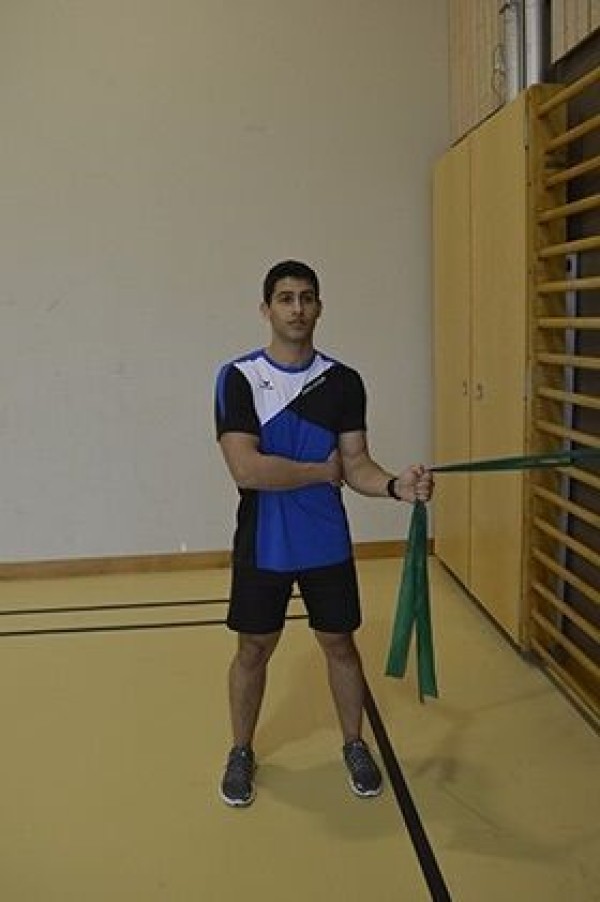

Attach the elastic band to the wall bars (or a tree, for example) at stomach height, stand shoulder-width apart (90 degree angle) to the wall bars (to the tree), arms stretched out towards the wall bars (tree) (to the left), grasp the elastic band with both hands, bring the stretched arms in front of the body at shoulder height and back to the starting position, keeping the upper body stable.
Attention:
No torso rotation, the movement only takes place in the shoulder joint.
Lighten:
Choose an elastic band with less resistance.
Harden:
Choose an elastic band with greater resistance.
1 elasticated rubber band
1 wall bar/tree
Bring your arms in front of your body while standing (right) ► internal rotation
Power
Individual work


Attach the elastic band to the wall bars (or a tree, for example) at stomach height, stand shoulder-width apart (90 degree angle) to the wall bars (tree), arms stretched out towards the wall bars (tree) (to the right), grasp the elastic band with both hands, bring the stretched arms in front of the body at shoulder height and back to the starting position, keeping the upper body stable.
Attention:
No torso rotation, the movement only takes place in the shoulder joint.
Lighten:
Choose an elastic band with less resistance.
Harden:
Choose an elastic band with greater resistance.
1 elasticated rubber band
1 wall bar/tree
Breathing exercise: 20 in a row
Relaxation
Individual work
Back position. Perform the following breathing cycle four times without pausing: Four short breaths followed by one long breath. Make sure you breathe through your nose and combine the inhalation with the exhalation (circular rhythm). Take the first four breaths calmly and evenly, inhale deeply into your chest on the fifth breath and exhale in a relaxed manner.
No equipment required (optional in the hall: one soft mat per participant)
Breathing exercise: 5 x 8
Relaxation
Individual work
Lie on your back. Inhale slowly and count to five. Pause briefly and count to eight as you exhale. Perform this breathing cycle five times in succession.
Breathing exercise: from 1 to 20
Relaxation
Individual work
Back position. Slowly count to 20. Breathe out for all odd numbers with your eyes closed and breathe in for the even numbers with your eyes open. From the number 16 onwards, imagine that your eyes are getting heavier and heavier and open them less wide. At 20, keep your eyes closed after exhaling and remain in a resting position for a while (three to five minutes)
.No equipment required (optional in the hall: one soft mat per participant)
Breathing exercise: Centring
Relaxation
Individual work
Breathe consciously while lying comfortably on your back or sitting with your eyes closed. Focus your attention on the centre of your abdomen - approx. one centimetre below your navel. Slowly inhale deeply into the centre of the abdomen (push the abdominal wall outwards) and exhale slowly (let the abdominal wall fall inwards). Two to three minutes in the practice phase, as an application only a few breaths long.
No equipment required (optional in the hall: one soft mat per participant)
Jump onto an object ► jump
Power
Individual work

Jump with both legs onto the object on the ground (e.g. tyre) and back down to the starting position.
Attention:
Keep your upper body upright and cushion your landing.
Lighten:
Select a lower element; lower cadence.
Harden:
Higher cadence; additional weight (on the feet); standing on the object, jump back up to the starting position.
1 tyre (10DM)
1 tyre (DURO)/helmet ► Make the exercise easier
2 weight cuffs/1 weight waistcoat ► Make the exercise more difficult (additional weight)
Step onto an object (left) ► step up
Power
Individual work



Stand upright in front of the plyo box (the vaulting box - 1 intermediate element plus top), step onto the object first with the left leg, then with the other leg and back down to the starting position (stair climbing). A weight is held in both hands or in the arms (dumbbells, kettlebells, medicine ball). The start/starting leg remains identical for each exercise.
Attention:
Keep your upper body upright.
Lighten:
Select a lower element; lower cadence.
Harden:
Select a higher element; higher cadence; more weight/greater load; additional weight (on the feet).
1 plyo box/swivel box
2 dumbbells/kettlebells/1 medicine ball
2 weight cuffs/1 weight waistcoat ► make the exercise more difficult (additional weight)
Step onto an object (left) ► step up
Power
Individual work




Stand upright in front of the plyo box (the vaulting box - 1 intermediate element plus top), first step onto the object with the left leg, then with the other leg and back down to the starting position (stair climbing). The start/starting leg remains the same for each exercise.
Attention:
Keep your upper body upright.
Lighten:
Select a lower element; lower cadence.
Harden:
Choose a higher element; higher cadence; hold the weight in both hands; additional weight (on the feet).
Variation:
Alternate with the left/right foot first (more demanding in terms of coordination).
1 plyo box/swing box
2 dumbbells/kettlebells/1 medicine ball ► make the exercise more difficult (additional weight)
2 weight cuffs/1 weight waistcoat ► make the exercise more difficult (additional weight)
Step onto an object (left) ► step up
Power
Individual work
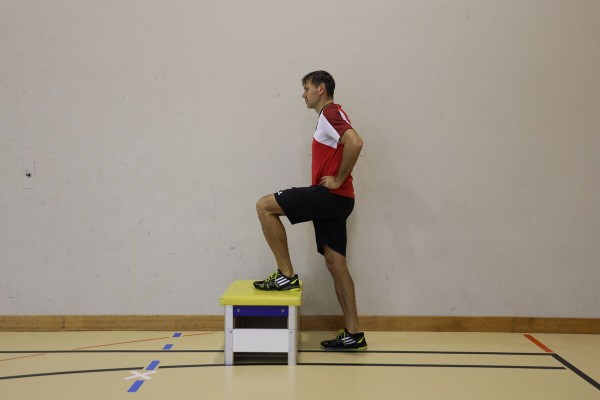
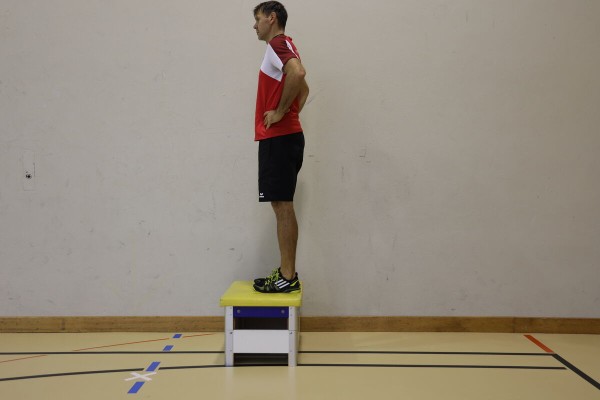
Stand upright in front of the plyo box (the vaulting box - 1 intermediate element plus top), with one leg stretched out on the floor and the other (left) leg bent on the raised surface. Extend the bent leg and at the same time move the leg placed on the floor onto the base in order to stand on the box/swinging box. Then move both legs back to the starting position (right leg back on the floor, left leg remains on the raised surface).
Attention:
Keep your upper body upright, distribute your weight over your entire foot, push your knees outwards (do not tilt inwards).
Lighten:
Select a lower element.
Harden:
Select a higher element; additional weight (on the back, in the hands or on the foot).
1 plyo box/swinging box
2 dumbbells/kettlebells/1 medicine ball/weight cuff/weight waistcoat ► make the exercise more difficult (additional weight)
Step onto an object (left) ► step up
Power
Individual work

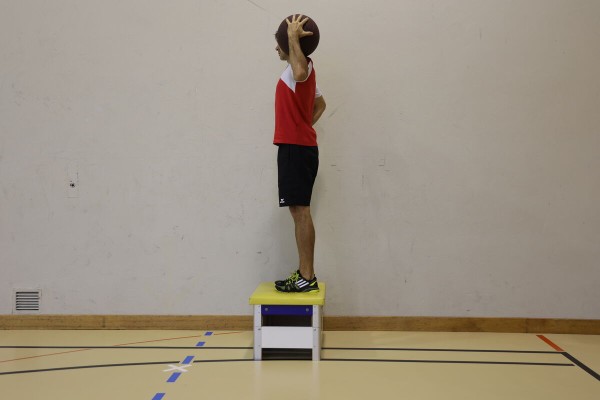
Stand upright in front of the plyo box (the vaulting box - 1 intermediate element plus top), with one leg stretched out on the floor and the other (left) leg bent on the raised surface. A medicine ball (or another weight such as a dumbbell or kettlebell) is held on the shoulder with a bent arm on the side where the leg is placed on the raised surface. Extend the bent leg and at the same time move the leg placed on the floor onto the base to get to a standing position on the box/swinging box. Then move both legs back to the starting position (right leg back on the floor, left leg remains on the raised surface).
Attention:
Keep your upper body upright, distribute your weight over your entire foot, push your knees outwards (do not tilt inwards).
Lighten:
Select a lower element; do not hold any weight on the shoulder.
Harden:
Select a higher element; more weight; additional weight on the foot.
Variation:
Hold a weight (dumbbell or kettlebell) in both hands with hanging arms.
1 plyo box/swinging box
1 medicine ball/dumbbell/kettlebell
1 weight sleeve/weight waistcoat ► make the exercise more difficult (additional weight)
1 additional dumbbell/kettlebell ► variation of the exercise
Step onto an object (right) ► step up
Power
Individual work



Stand upright in front of the plyo box (the vaulting box - 1 intermediate element plus top), step onto the object first with the right leg, then with the other leg and back down to the starting position (stair climbing). A weight is held in both hands or in the arms (dumbbells, kettlebells, medicine ball). The start/starting leg remains identical for each exercise.
Attention:
Keep your upper body upright.
Lighten:
Select a lower element; lower cadence.
Harden:
Select a higher element; higher cadence; more weight/greater load; additional weight (on the feet).
1 plyo box/swivel box
2 dumbbells/kettlebells/1 medicine ball
2 weight cuffs/1 weight waistcoat ► make the exercise more difficult (additional weight)
Step onto an object (right) ► step up
Power
Individual work




Stand upright in front of the plyo box (the vaulting box - 1 intermediate element plus top), first step onto the object with the right leg, then with the other leg and back down to the starting position (stair climbing). The start/starting leg remains the same for each exercise.
Attention:
Keep your upper body upright.
Lighten:
Select a lower element; lower cadence.
Harden:
Select a higher element; higher cadence; hold the weight in both hands; additional weight (on the feet).
1 plyo box/swing box
2 dumbbells/kettlebells/1 medicine ball ► make the exercise more difficult (additional weight)
2 weight cuffs/1 weight waistcoat ► make the exercise more difficult (additional weight)
Step onto an object (right) ► step up
Power
Individual work
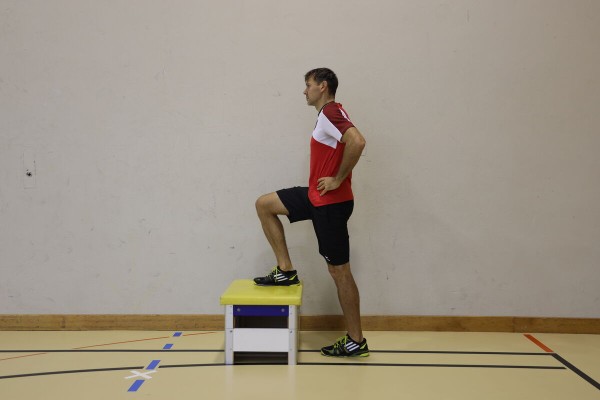

Stand upright in front of the plyo box (the vaulting box - 1 intermediate element plus top), with one leg stretched out on the floor and the other (right) leg bent on the raised surface. Extend the bent leg and at the same time move the leg placed on the floor onto the base in order to stand on the box/swinging box. Then move both legs back to the starting position (left leg back on the floor, right leg remains on the raised surface).
Attention:
Keep your upper body upright, distribute your weight over your entire foot, push your knees outwards (do not tilt inwards).
Lighten:
Select a lower element.
Harden:
Select a higher element; additional weight (on the back, in the hands or on the foot).
1 plyo box/swinging box
2 dumbbells/kettlebells/1 medicine ball/weight cuff/weight waistcoat ► make the exercise more difficult (additional weight)
Step onto an object (right) ► step up
Power
Individual work
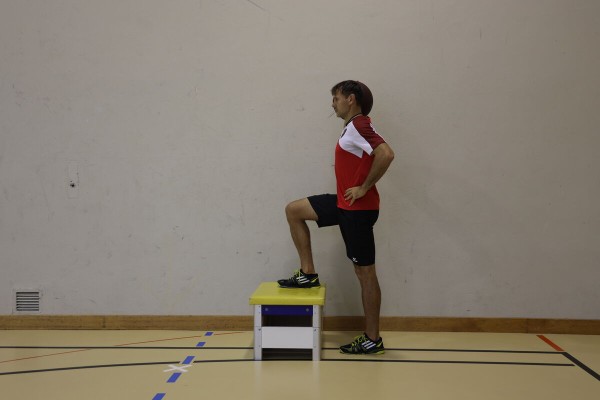
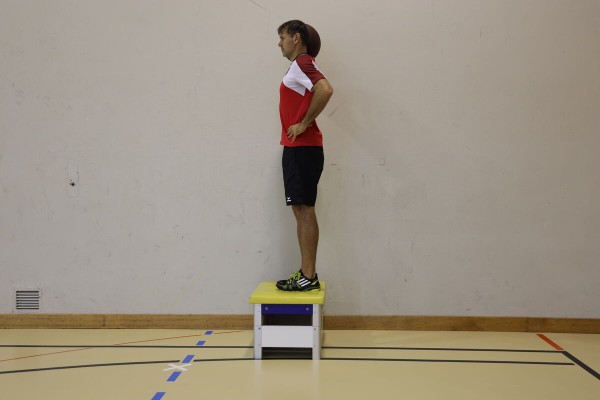
Stand upright in front of the plyo box (the vaulting box - 1 intermediate element plus top), with one leg stretched out on the floor and the other (right) leg bent on the raised surface. A medicine ball (or another weight such as a dumbbell or kettlebell) is held on the shoulder with a bent arm on the side where the leg is placed on the raised surface. Extend the bent leg and at the same time move the leg placed on the floor onto the base to get to a standing position on the box/swinging box. Then move both legs back to the starting position (left leg back on the floor, right leg remains on the raised surface).
Attention:
Keep your upper body upright, distribute your weight over your entire foot, push your knees outwards (do not tilt inwards).
Lighten:
Select a lower element; do not hold any weight on the shoulder.
Harden:
Select a higher element; more weight; additional weight on the foot.
Variation:
Hold a weight (dumbbell or kettlebell) in both hands with hanging arms.
1 plyo box/swinging box
1 medicine ball/dumbbell/kettlebell
1 weight sleeve/weight waistcoat ► make the exercise more difficult (additional weight)
1 additional dumbbell/kettlebell ► variation of the exercise
Step up onto an object ► step up
Power
Individual work


Stand upright with your feet shoulder-width apart in front of the object, step onto the object lying on the floor (e.g. tyre) first with one leg and then with the other and then back down to the starting position (climbing stairs). Switch the starting position/leg too.
Attention:
Keep your upper body upright.
Lighten:
Select a lower element; lower cadence.
Harden:
Higher cadence; additional weight (on the feet); standing on the object, two-legged jump upwards back to the starting position.
Variant:
Alternate with the left/right foot first (more demanding in terms of coordination).
1 tyre (10DM)
1 tyre (DURO)/helmet ► make the exercise easier (position)
2 weight cuffs/1 weight waistcoat ► make the exercise more difficult (additional weight)
Step up onto an object ► step up
Power
Individual work



Stand upright with your feet shoulder-width apart in front of the long bench, step onto the long bench first with one leg and then the other and then back down to the starting position (stair climbing). Alternate start/leg as well.
Attention:
Keep your upper body upright.
Lighten:
Select a lower element (e.g. vaulting box top); lower cadence.
Harden:
Choose a higher element; higher cadence; additional weight (on the feet); two-legged jump into the air after standing on the long bench.
Variant:
Alternate with the left/right foot first (more demanding in terms of coordination).
1 long bench
1 vaulting box top section ► easier exercise (position)
2 vaulting box elements (incl. top section) ► more difficult exercise (position)
2 weight cuffs/1 weight waistcoat ► more difficult exercise (additional weight)
Step onto an object alternately ► step up
Power
Individual work


Stand upright in front of the (flat) bench, first with one leg, then with the other, climb onto the bench and back down to the starting position (stair climbing). Change starting position/leg after each exercise or after a few repetitions.
Starting position:
- From an upright, shoulder-width stance, position one foot on the bench
- Hold the weight in your hands on one or both sides or place it on your shoulders
- Tense your abdominal and gluteal muscles
Finishing position:
- Stand upright on the bench
- Keep your back straight
Attention:
Keep your upper body upright, distribute your weight over your entire foot, push your knees outwards (do not tilt inwards).
Variant:
Alternate with the left/right foot first (more demanding in terms of coordination).
1-2 dumbbell(s)/kettlebell(s) or 1 barbell
Step onto an object alternately ► step up
Power
Individual work






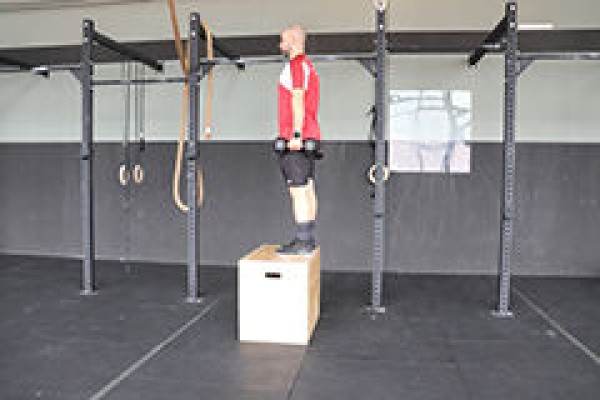


Stand upright in front of the plyo box (the vaulting box - 1 intermediate element plus top), step onto the object first with one leg, then with the other and back down to the starting position (stair climbing). A weight is held in both hands or in the arms (dumbbells, kettlebells, medicine ball). Change the starting position/leg after each exercise.
Attention:
Keep your upper body upright.
Lighten:
Select a lower element; lower cadence.
Harden:
Select a higher element; higher cadence; more weight/greater load; additional weight (on the feet).
1 plyo box/swivel box
2 dumbbells/kettlebells/1 medicine ball
2 weight cuffs/1 weight waistcoat ► make the exercise more difficult (additional weight)
Step onto an object alternately ► step up
Power
Individual work


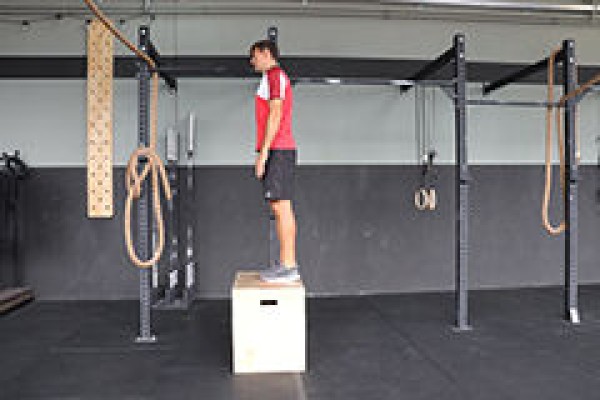


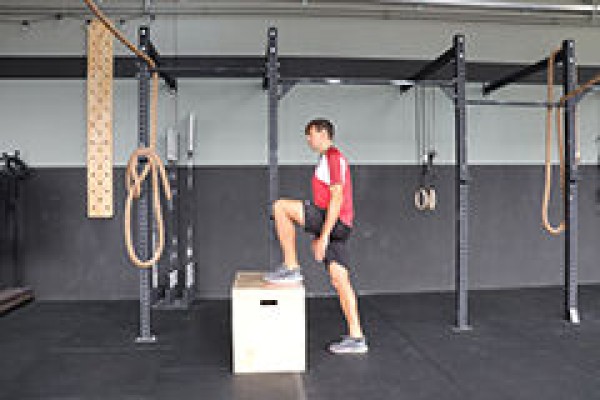



Stand upright in front of the plyo box (the vaulting box - 1 intermediate element plus top), first step onto the object with one leg, then with the other leg and back down to the starting position (stair climbing). Change the starting position/leg after each exercise.
Attention:
Keep the upper body upright.
Lighten:
Select a lower element; lower cadence.
Harden:
Select a higher element; higher cadence; hold the weight in both hands; additional weight (on the feet).
1 plyo box/swing box
2 dumbbells/kettlebells/1 medicine ball ► make the exercise more difficult (additional weight)
2 weight cuffs/1 weight waistcoat ► make the exercise more difficult (additional weight)